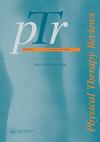作为维持运动干预效果的一种手段的运动加强训练——一项系统综述
IF 0.8
Q4 REHABILITATION
引用次数: 4
摘要
摘要背景:众所周知,运动有许多有益的效果。然而,长期坚持仍然是一项挑战。建议参加这个问题的一个概念是锻炼助推器会议(EBS)。然而,目前对EBS的了解是有限的。目的:本系统综述旨在总结和综合1)已报道的EBS对身体功能、疼痛、生活质量和社会成本的影响,2)描述所有临床人群运动干预后EBS的基本组成部分(频率、强度、类型和时间)。方法于2021年8月对7个数据库(MEDLINE、EMBASE、CINAHL、SportDISCUS、物理治疗证据数据库PEDro、Web of Science和Cochrane对照试验中央登记册)进行电子检索。纳入的研究是在所有临床人群中进行运动干预的随机对照试验(RCT),随后进行一段时间的EBS或未接受EBS的对照组。结果:对膝关节骨性关节炎分别进行了5项研究(n = 4) 和腰痛(n = 1) ,报告了四种不同的随机对照试验。四项研究存在潜在的高偏倚风险,而一项研究被认为存在一些担忧。一项研究发现,EBS对西安大略大学和麦克马斯特大学关节炎指数(WOMAC)评分−46.0(-80.0,−12.0)有积极影响,而其他研究没有发现任何差异。EBS的频率范围为0.09 − 一项研究发现EBS具有成本效益。结论:目前的证据表明EBS对身体功能和疼痛没有影响,或者充其量是中等影响。然而,试验数量少,潜在的偏见风险,加上试验干预措施的多样性,阻碍了得出确切的结论。本文章由计算机程序翻译,如有差异,请以英文原文为准。
Exercise booster sessions as a mean to maintain the effect of an exercise-intervention - A systematic review
Abstract Background: Exercise is known to have many beneficial effects. Nevertheless, long-term adherence remains a challenge. A concept suggested to attend this problem is Exercise Booster Sessions (EBS). However, the current knowledge on EBS is limited. Objectives: This systematic review aimed to summarize and synthesize 1) the reported effects of EBS on physical function, pain, quality-of-life and societal costs and 2) delineate the basic components of EBS (frequency, intensity, type and time) following an exercise intervention in all clinical populations. Methods Seven databases (MEDLINE, EMBASE, CINAHL, SportDISCUS, Physiotherapy Evidence Database PEDro, Web of Science, and Cochrane Central Register of Controlled Trials) were electronically searched in August 2021. Included studies were randomized controlled trials (RCTs) of exercise interventions in all clinical populations followed by a period of EBS or a control group not receiving EBS. Results: Five studies on respectively knee osteoarthritis (n = 4) and low back pain (n = 1), reporting four different RCTs, were included. Four studies had a potential high risk of bias, whereas one was rated to have some concerns. One study found a positive effect of EBS on the Western Ontario and McMaster Universities Arthritis Index (WOMAC) score, −46.0 (-80.0, −12.0), whereas the others did not find any differences. The frequency of EBS ranged from 0.09 − 1 session/week, and one study found EBS to be cost-effective. Conclusions: Current evidence suggests no or at best moderate effects of EBS on physical function and pain. However, the low number of trials, the potential risk of bias, plus the diversity in trial interventions prevent a firm conclusion.
求助全文
通过发布文献求助,成功后即可免费获取论文全文。
去求助
来源期刊

Physical Therapy Reviews
REHABILITATION-
CiteScore
1.30
自引率
0.00%
发文量
26
期刊介绍:
Physical Therapy Reviews is an international journal which aims to publish contemporary reviews, discussion papers and editorials within physical therapy, and in those basic and clinical sciences which are the basis of physical therapy. The journal is aimed at all those involved in research, teaching and practice within the area of physical therapy. Reviews (both descriptive and systematic) are invited in the following areas, which reflect the breadth and diversity of practice within physical therapy: •neurological rehabilitation •movement and exercise •orthopaedics and rheumatology •manual therapy and massage •sports medicine •measurement •chest physiotherapy •electrotherapeutics •obstetrics and gynaecology •complementary therapies •professional issues •musculoskeletal rehabilitation
 求助内容:
求助内容: 应助结果提醒方式:
应助结果提醒方式:


